Difference between revisions of "Carving leather"
| (7 intermediate revisions by one user not shown) | |||
| Line 12: | Line 12: | ||
==Carving leather - stamping leather== | ==Carving leather - stamping leather== | ||
| − | Carving is a traditional method of | + | Carving is a traditional method of [[leather workshop|leather working]] and is used to add decoration. By means of carving tools (metal stamps cast into certain shapes), lines, grooves and patterns, such as monograms or coats of arms, are pressed, stamped and punched into the leather. Carving tools are available in many variations, shapes and sizes. They are also available with leaf shapes and embellishments. |
| − | Best for carving is [[Thickness of leather|thick]], [[Leather grain - Grain side|fine grained]], [[Vegetable-tanned leather]] without [[finish|binder based finish]]. Such leather has the necessary stability for processing and the motifs | + | Best for carving is [[Thickness of leather|thick]], [[Leather grain - Grain side|fine grained]], [[Vegetable-tanned leather]] without [[finish|binder-based finish]]. Such leather has the necessary stability for processing and displays the motifs much better. The motifs are applied with a hammer firmly on the leather. Such leather is usually moistened with a sponge or cloth beforehand. This is re-done on different areas of the leather and the process is repeated until the desired pattern is complete. Applying great force is not necessary. Due to the moistening, the leather fibre is swollen and deforms easily and remains stable after drying. |
Basically, this work is very easy. But as with all the arts, there are people who have a talent to "paint" motifs on leather. | Basically, this work is very easy. But as with all the arts, there are people who have a talent to "paint" motifs on leather. | ||
| Line 22: | Line 22: | ||
<p align=center> | <p align=center> | ||
| − | <flashow> | + | <flashow>//www.youtube.com/v/-uj3uPDipVA&fs=1&color1=0x660000&color2=0x550000&border=1|width=500|height=281,25</flashow> |
</p> | </p> | ||
<p align=center> | <p align=center> | ||
| − | ''Beautiful leather | + | <flashow>//www.youtube.com/v/MpEbBjTxkzE&fs=1&color1=0x660000&color2=0x550000&border=1|width=500|height=281,25</flashow> |
| + | </p> | ||
| + | <p align=center> | ||
| + | ''Beautiful leather work.'' | ||
</p> | </p> | ||
| − | Leather of [[Leather saddle|Western saddles]], [[leather belt|belts]] or [[leather bag|bags]] is more frequently carved. | + | Leather of [[Leather saddle|Western saddles]], [[leather belt|belts]] or [[leather bag|bags]] is more frequently carved. The technique was at a high point in Europe during the Middle Ages. Nowadays, this elaborate leather work has become less prevalent. For Germany, it is estimated that less than ten percent of all [[Saddlers - Upholsterers|saddlers]] are able to do such work. In the USA, carving leather is more common. |
Larger motifs are [[Embossed leather|embossed]] by means of embossing stamps. | Larger motifs are [[Embossed leather|embossed]] by means of embossing stamps. | ||
| Line 86: | Line 89: | ||
<p align=center> | <p align=center> | ||
''Great art: the leatherwork by [http://www.stanleyauleatherart.com/ Stanley Au Leather Art] from Hong Kong.''<br></p> | ''Great art: the leatherwork by [http://www.stanleyauleatherart.com/ Stanley Au Leather Art] from Hong Kong.''<br></p> | ||
| − | |||
| − | |||
| − | |||
| − | |||
| − | |||
| − | |||
| − | |||
| − | |||
<p> </p> | <p> </p> | ||
| Line 121: | Line 116: | ||
==Leather carving tools - Leather stamping tools== | ==Leather carving tools - Leather stamping tools== | ||
| − | For carving and stamping of leather various tools are used | + | For carving and stamping of leather various tools are used to deform or cut the leather fibres. |
| Line 149: | Line 144: | ||
<p align=center> | <p align=center> | ||
| − | <flashow> | + | <flashow>//www.youtube.com/v/mhYUU3soIac&fs=1&color1=0x660000&color2=0x550000&border=1|width=500|height=281,25</flashow> |
</p> | </p> | ||
<p align=center> | <p align=center> | ||
| Line 157: | Line 152: | ||
<p align=center> | <p align=center> | ||
| − | <flashow> | + | <flashow>//www.youtube.com/v/MZblM8XdNJQ&fs=1&color1=0x660000&color2=0x550000&border=1|width=500|height=281,25</flashow> |
</p> | </p> | ||
<p align=center> | <p align=center> | ||
| Line 168: | Line 163: | ||
==Leather cutting== | ==Leather cutting== | ||
| − | Leather can be embossed or carved with motifs. Another technique is | + | Leather can be embossed or carved with motifs. Another technique is leather cutting, which comes from the Middle Ages. Here the leather is wetted (soaked), heated and then superficially cut with a sharp knife. It is not cut through. With a further [[Leather workshop#Leather tools|leather tool]], the cutting edges are then deformed and supplemented by motifs. This technique was used in [[Leather book cover|book binding]], [[weapon leather]], boxes and [[Leather chest|chests]]. |
| Line 200: | Line 195: | ||
''A leather case with carved signatures by cutting.'' | ''A leather case with carved signatures by cutting.'' | ||
</p> | </p> | ||
| + | |||
| + | |||
| + | ==[[Gold leather#Hand gilding - Gold print - Press gilding - Engraving calligraphy|Engraving calligraphy]]== | ||
| + | Engraving calligraphy is leather art. Only very skilled specialists are able to transfer [[Gold leather|gold foil]] by heat so beautifully on leather. | ||
| Line 211: | Line 210: | ||
</p> | </p> | ||
<p align=center> | <p align=center> | ||
| − | ''[[Leather shoes|Shoes]] with [[hole punching]] and machine milled decorative lines.'' | + | ''[[Leather shoes|Shoes]] with [[hole punching]] and machine-milled decorative lines.'' |
</p> | </p> | ||
| Line 217: | Line 216: | ||
<p> </p> | <p> </p> | ||
<p align=center> | <p align=center> | ||
| − | <flashow> | + | <flashow>//www.youtube.com/v/sYzdxiXI-2g&fs=1&color1=0x660000&color2=0x550000&border=1|width=500|height=281,25</flashow> |
</p> | </p> | ||
<p align=center> | <p align=center> | ||
Revision as of 20:31, 14 June 2019
A master of this craftsmanship: Stanley Au Leather Art from Hong Kong.
Contents
Carving leather - stamping leather
Carving is a traditional method of leather working and is used to add decoration. By means of carving tools (metal stamps cast into certain shapes), lines, grooves and patterns, such as monograms or coats of arms, are pressed, stamped and punched into the leather. Carving tools are available in many variations, shapes and sizes. They are also available with leaf shapes and embellishments.
Best for carving is thick, fine grained, Vegetable-tanned leather without binder-based finish. Such leather has the necessary stability for processing and displays the motifs much better. The motifs are applied with a hammer firmly on the leather. Such leather is usually moistened with a sponge or cloth beforehand. This is re-done on different areas of the leather and the process is repeated until the desired pattern is complete. Applying great force is not necessary. Due to the moistening, the leather fibre is swollen and deforms easily and remains stable after drying.
Basically, this work is very easy. But as with all the arts, there are people who have a talent to "paint" motifs on leather.
For further adornment, the leather can be painted, decorated with gold leaf or patinated with transparent leather colours.
Beautiful leather work.
Leather of Western saddles, belts or bags is more frequently carved. The technique was at a high point in Europe during the Middle Ages. Nowadays, this elaborate leather work has become less prevalent. For Germany, it is estimated that less than ten percent of all saddlers are able to do such work. In the USA, carving leather is more common.
Larger motifs are embossed by means of embossing stamps.
Relatively new is the lasering of leather. This is considerably easier because no special manual sills are required. Using images, a PC and a laser, motifs are burnt into the leather surface.
Carved seat cushion in Lima, the capital of Peru.
Carved leather boots (DLM - German Leather Museum in Offenbach.
Extraordinary fine work from the leather workshop of Selestudio.
Great art: the leatherwork by Stanley Au Leather Art from Hong Kong.
Carved motorcycle saddles with braiding.
Carved leather book covers of DragosMan.
Carved leather handbags and hunting bag of Selestudio.
Leather carving tools - Leather stamping tools
For carving and stamping of leather various tools are used to deform or cut the leather fibres.
Photo www.centruldepiele.ro.
Leather tools for processing leather. - Character sets.
Videos about carving
The carving of a flower in the leather workshop.
The carving of a skull in the leather workshop.
Leather cutting
Leather can be embossed or carved with motifs. Another technique is leather cutting, which comes from the Middle Ages. Here the leather is wetted (soaked), heated and then superficially cut with a sharp knife. It is not cut through. With a further leather tool, the cutting edges are then deformed and supplemented by motifs. This technique was used in book binding, weapon leather, boxes and chests.
Leather cutting in very old leather. Book cover (annual figures, etc.). - Ceremonial shield made of leather, Milan around 1540 (DLM - German Leather Museum in Offenbach).
Cutting work in new leather. - Shoe and bag from London.
A leather case with carved signatures by cutting.
Engraving calligraphy
Engraving calligraphy is leather art. Only very skilled specialists are able to transfer gold foil by heat so beautifully on leather.
Milling
For mass production, motifs are milled into leather. This ensures consistent optics and is much faster than manual work.
Shoes with hole punching and machine-milled decorative lines.
A video about painting on leather, perforating leather, carving leather, embossing leather and several other methods to create motifs on leather.
Other possibilities how to provide leather with designs
- Embossed leather
- Laser engraving - Laser cutting leather
- Perforated leather
- Hole punching
- Embroidery
- Leather seams
- Leather imprint
- Formed leather
- Painting on leather
- Braided leather
- Leather etching & engraving
- Leather tattoo
- Glued leather strips
- Burning designs on leather







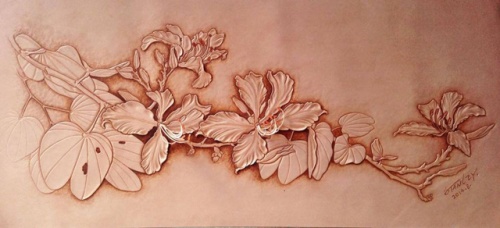
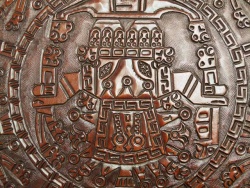
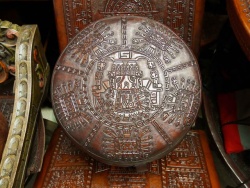
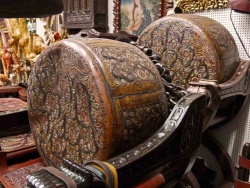
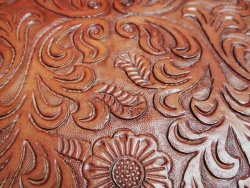
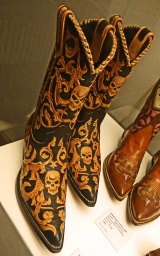
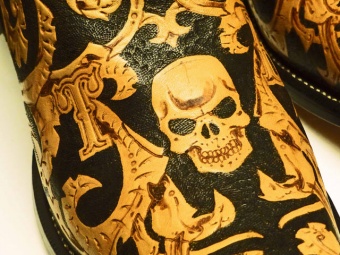
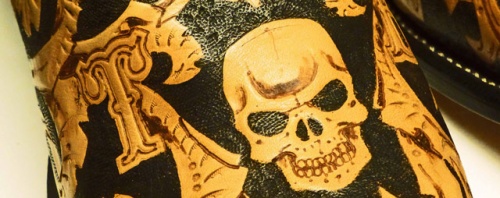
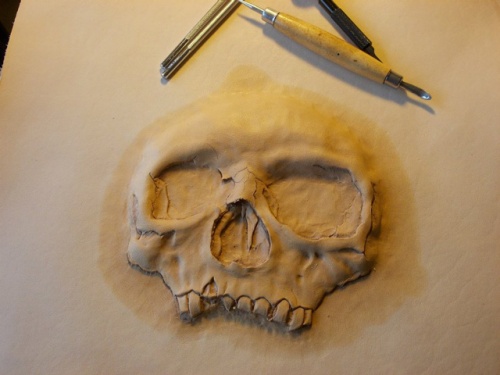
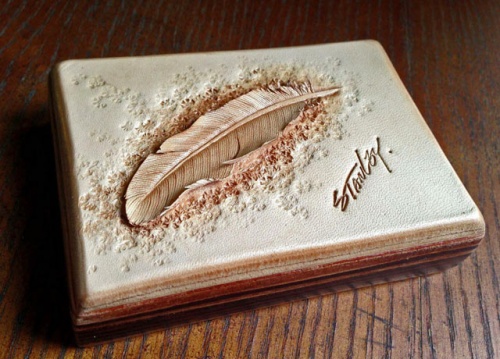
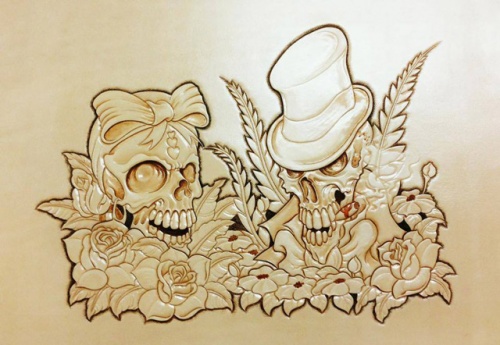
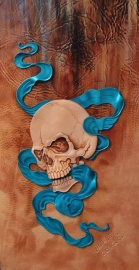
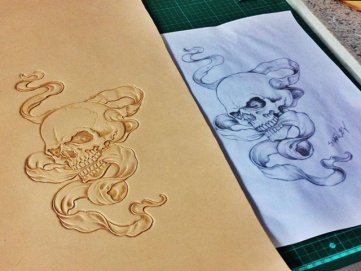
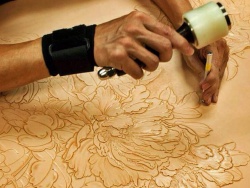
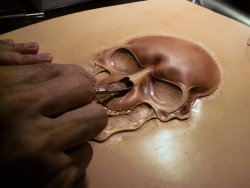
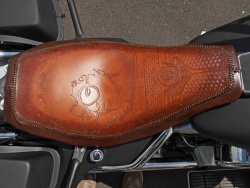
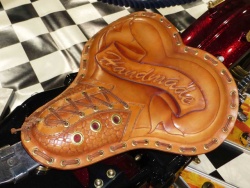
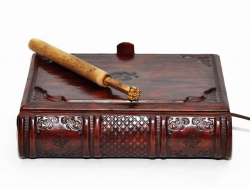
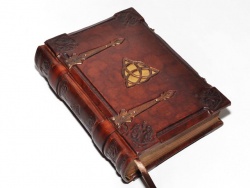
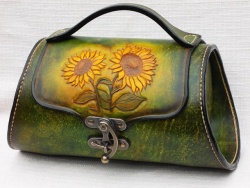
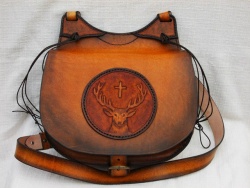
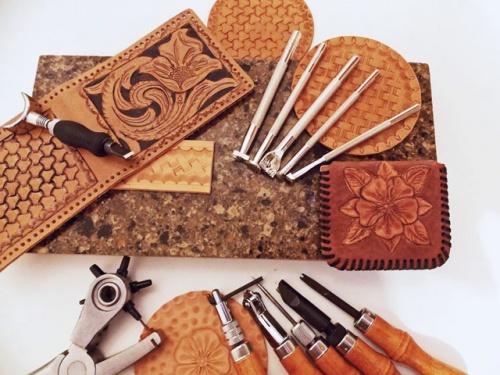
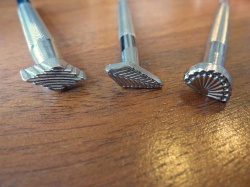
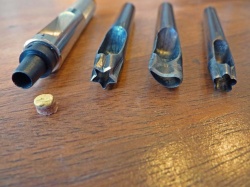
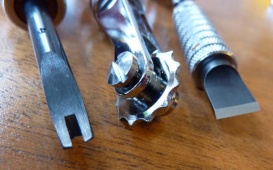
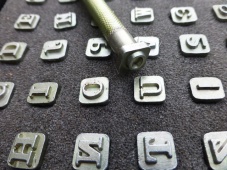
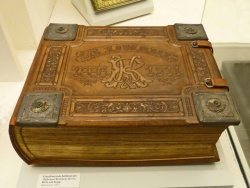
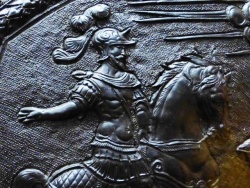
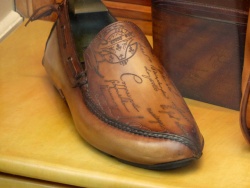
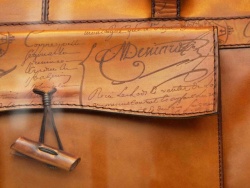
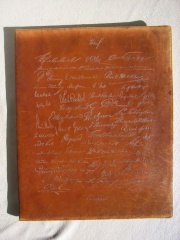
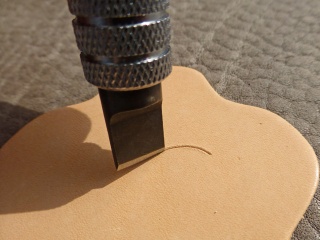
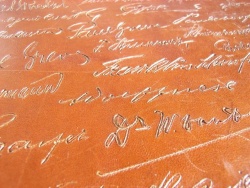
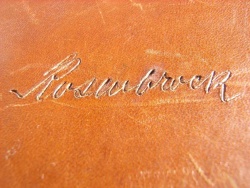
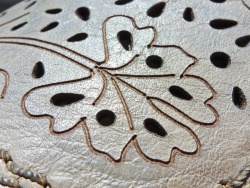
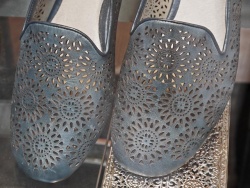

 a kotori web solution
a kotori web solution